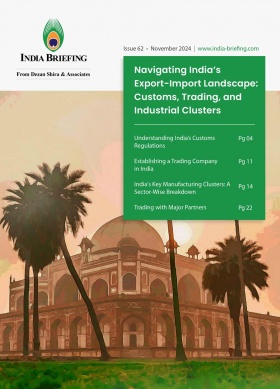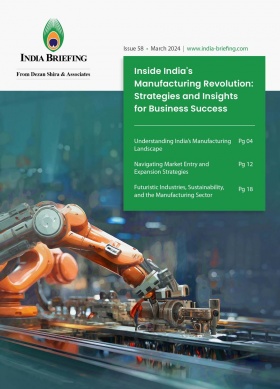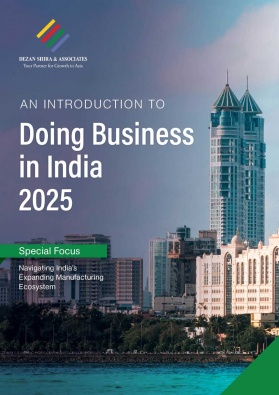A Guide to MSMEs in India for Foreign Investors
We provide a comprehensive guide on the MSME sector in India for the benefit of foreign investors, and discuss their contribution to the Indian GDP, key preferential schemes, and sector-wise opportunities.
In the Indian business landscape, micro, small, and medium enterprises (MSMEs) hold immense significance as key drivers of growth, employment, and innovation.
MSMEs act as crucial ancillary units to large businesses, providing vital support and fostering synergistic collaborations. Their presence creates a dynamic marketplace that encourages collaboration, partnership, and innovation.
With favorable government initiatives and policies, they enjoy a conducive business environment that promotes investment, enhances competitiveness, and fuels their growth. Together, MSMEs and large enterprises form a powerful ecosystem that propels Indian businesses towards sustainable growth and prosperity.
How MSMEs make up India’s economic backbone
MSMEs, categorized based on their investment in plant and machinery or equipment, make up around 33 percent of India’s GDP and contribute to around 45 percent of India’s exports. As reliable and agile business partners, MSMEs in India can contribute to the diversification and expansion of supply chains, while their entrepreneurial spirit drives innovation within their sectors. Central and state government support measures for MSMEs, especially in priority sectors, can prove to be an attractive proposition for foreign investors.
|
Year |
Share of MSME Gross Value Added (GVA) in All India GDP |
Share of MSME Manufacturing GVA in All India Manufacturing GVA |
|
2019-20 |
30.5% |
40.67% |
|
2020-21 |
27.3% |
40.30% |
|
2021-22 |
29.6% |
40.83% |
|
2022-23 |
30.1% |
35.4% |
Source: Ministry of Micro,Small & Medium Enterprises
|
Year |
% Share of Export of MSME Related Products in All India Export |
|
2019-20 |
49.75% |
|
2020-21 |
49.35% |
|
2021-22 |
45.03% |
|
2022-23 |
43.59% |
|
2023-24 |
45.73% |
|
2024-25*
|
45.79% |
* Data up to May 2024.
Source: Ministry of Finance
India’s 59.3 million registered MSMEs employ over 250 million people and contribute significantly to the country’s economic output. In 2023-24, MSME-related products made up 45.73 percent of India’s total exports, highlighting their role in establishing the country as a global manufacturing hub.
The 2025-26 Union Budget aims to build on this foundation by promoting innovation, enhancing competitiveness, and improving access to resources. Through these measures, the government seeks to empower MSMEs to expand their reach and strengthen their contribution to India’s economic growth.
The budget outlay for MSMEs under the Union Budget 2025-26 is an estimated INR 231.68 billion.
MSME India guide for foreign investors
Definition and classification criteria
The Micro, Small and Medium Enterprises Development (MSMED) Act, 2006 governs the coverage and investment ceiling of MSMEs in India.
Since July 1, 2020, a new definition of MSMEs has come into effect, focusing on their net turnover and net investments in essential assets such as plants, machinery, and equipment. This revised definition applies to both goods-based and service-based MSMEs, providing a comprehensive framework for classification.
Under the new definition, net investment refers to the difference between the investments made in pollution control, research and development, and the installation of safety devices, and the total investment in plant and machinery. This criterion ensures that MSMEs prioritize sustainable practices, innovation, and safety measures in their operations.
Net turnover, on the other hand, is determined by subtracting the export turnover from the total turnover of the MSME. This metric captures the domestic business activities and the extent of international trade for the enterprise.
Revised classification criteria under Union Budget 2025-26
|
MSME Entity Classification |
Investment |
Turnover |
||
|
|
Current |
Revised |
Current |
Revised |
|
Micro enterprises |
INR 10 million |
INR 25 million |
INR 50 million |
INR 100 million |
|
Small enterprises |
INR 100 million |
INR 250 million |
INR 500 million |
INR 1 billion |
|
Medium enterprises |
INR 500 million |
INR 1.25 billion |
INR 2.5 billion |
INR 5 billion |
MSME registration process
- Entrepreneurs are required to register on the Udyam Registration Portal, selecting either “new registration” or “EM-II registration” based on their status.
- To access the PAN Verification page, entrepreneurs need to provide their Aadhaar number and name, followed by clicking the “Validate and Generate OTP” button.
- The portal validates the entrepreneur’s PAN number by entering the organization type and PAN number.
- Personal and business information must be provided by entrepreneurs during the Udyam Registration process.
- To obtain an Udyam Registration Certificate, entrepreneurs need to enter investment and turnover details, make a declaration, submit the OTP, and complete the form submission. The Udyam Registration Portal also allows entrepreneurs to check the status of their MSME registration.
Sector and state-wise distribution, opportunities for investment, and export trends
India is home to approximately 60 million MSMEs, with the number of registered MSMEs reaching 59.3 million units as of February 4, 2025. Maharashtra, Tamil Nadu, and Uttar Pradesh are the top three Indian states with the most registered MSMEs in India, cumulatively accounting for over a 40 percent share, per a CBRE-CREDAI report. Other Indian states with a significant presence of MSMEs include Gujarat, Rajasthan, Delhi, Karnataka, and West Bengal.
Service enterprises accounted for the majority (64 percent) of registered Indian MSMEs, while manufacturing enterprises made up 36 percent.
The manufacturing output in India is significantly supported by MSMEs. Among the diverse industries within the manufacturing sector, three sectors have experienced notable growth, including food products, textiles, and fabricated metal products. In the services sector, MSMEs have also made substantial contributions. The education sector stands out, followed by retail trade and the healthcare sector.
Major MSME clusters in India
Major MSME clusters in India are located in various states across the country. These clusters have emerged as prominent hubs for MSME growth and development, offering a conducive environment for businesses to thrive. Some of the notable MSME clusters in India include:
- Maharashtra: Maharashtra is home to several MSME clusters, including Mumbai, Pune, Nashik, Aurangabad, and Nagpur. Renowned for their wide-ranging industries, these clusters operate in manufacturing, IT services, textiles, and engineering.
- Andhra Pradesh: Andhra Pradesh has significant MSME clusters in cities like Visakhapatnam, Vijayawada, Guntur, and Tirupati. These clusters are active in the textiles, food processing, leather, and engineering industries.
- Gujarat: Gujarat is renowned for its vibrant MSME clusters, particularly in cities like Ahmedabad, Vadodara, Surat, and Rajkot. These clusters are prominent in the textiles, chemicals, engineering, and pharmaceuticals industries.
- Tamil Nadu: Tamil Nadu boasts thriving MSME clusters in Chennai, Coimbatore, Tirupur, Madurai, and Trichy. These clusters excel in the textiles, automotive components, electronics, and IT service industries.
- West Bengal: West Bengal houses significant MSME clusters in Kolkata, Howrah, Durgapur, and Siliguri. These clusters are active in the textiles, jute, leather goods, and engineering industries.
- Uttar Pradesh: Uttar Pradesh has emerging MSME clusters in cities like Agra, Ghaziabad, Meerut, Noida, Kanpur, Lucknow, and Varanasi. These clusters operate in the textiles, leather goods, agro-based industries, and food processing industries.
- Kerala: Kerala is known for its MSME clusters in cities like Kochi, Thiruvananthapuram, Kozhikode, and Thrissur. These clusters specialize in tourism, spices, handlooms, and handicrafts.
Sector-based opportunities for MSME investors in India
The MSME sector in India offers a wide range of opportunities across diverse industries and their supply chain ecosystem: These include:
- Telecommunications: The ever-evolving telecommunications industry presents avenues for MSMEs to contribute to the development of infrastructure, networking solutions, and innovative services.
- Healthcare: With the growing focus on healthcare, MSMEs can explore opportunities in medical devices, digital health solutions, healthcare IT, telemedicine, and pharmaceutical manufacturing.
- Electronics: The demand for consumer electronics, electronic components, IoT devices, and smart solutions creates a favorable landscape for MSMEs specializing in electronics.
- Pharmaceuticals: MSMEs can engage in pharmaceutical manufacturing, research and development, contract manufacturing, and supply chain solutions within the thriving pharmaceutical sector.
- Tourism: The tourism industry offers scope for MSMEs to provide unique experiences, hospitality services, travel technology solutions, and sustainable tourism initiatives.
- Sustainability: MSMEs can contribute to sustainability through eco-friendly products, renewable energy solutions, waste management, and sustainable packaging.
- Hyper automation: MSMEs can leverage emerging technologies like artificial intelligence (AI), machine learning (ML), robotic process automation (RPA), and advanced analytics to provide automation solutions across industries, streamlining processes and enhancing efficiency.
- Information technology (IT) and IT-enabled services (ITeS): MSMEs specializing in software development, cybersecurity, IT consulting, cloud services, and digital marketing can thrive in the IT and ITeS industries.
- Chemical: Opportunities exist for MSMEs to engage in specialty chemicals, agrochemicals, pharmaceutical intermediates, and green chemistry solutions.
- Automotive: MSMEs can participate in automotive component manufacturing, electric vehicle technology, aftermarket services, and connected vehicle solutions.
- Renewables: With the emphasis on clean energy, MSMEs can contribute to solar power, wind energy, energy storage, and energy management solutions.
- Gems and jewelry: The gems and jewelry industry offer avenues for MSMEs specializing in design, manufacturing, export, and retail of precious and semi-precious stones and jewelry.
- Textile: MSMEs can explore opportunities in textile manufacturing, apparel design, fashion technology, and sustainable textiles.
- Food processing: The food processing sector provides avenues for MSMEs in food packaging, processing equipment, agri-business, and value-added food products.
- Drones-as-a-Service: MSMEs can offer drone-based services for mapping, aerial surveys, surveillance, agriculture, and logistics.
- Agriculture: MSMEs can play a significant role in agricultural technology, precision farming, farm mechanization, agri-inputs, and supply chain management.
India MSME exports: Trends and top export markets
In FY 2021-22, the top 10 export destinations for Indian MSMEs were the United States (US$54.7 billion), the United Arab Emirates (US$13.4 billion), Hong Kong (US$9.93 billion), the United Kingdom (US$7.54 billion), Germany (US$7.19 billion), China (US$5.16 billion), Belgium (US$4.73 billion), France (US$4.20 billion), the Netherlands (US$4.24 billion), and Italy (US$3.84 billion).
Incentives for MSMEs in India
The Ministry of MSME has implemented a range of initiatives with the objective of supporting MSME enterprises in various aspects, such as finance, technology, infrastructure, upskilling, and market development. By 2025, the ministry aims to enhance the sector’s GDP contribution by 50 percent.
Provisions for MSMEs under Union Budget 2025-26
The Union Budget 2025-26 introduces targeted measures to bolster the MSME sector by improving credit access, supporting first-time entrepreneurs, and promoting labor-intensive industries.
Revised MSME classification criteria
To facilitate growth and access to better resources, the investment and turnover limits for MSME classification have been increased by 2.5 times and 2 times, respectively. This move is expected to enhance efficiency, drive technological adoption, and boost employment.
Enhanced credit availability
- Increased credit guarantee: The credit guarantee cover for micro and small enterprises has been raised from INR 50 million to INR 100 million, unlocking INR 1.5 trillion in additional credit over five years.
- Startups: The guarantee cover for startups will double from INR 100 million to INR 200 million, with a 1% reduced fee for loans in 27 priority sectors.
- Exporter MSMEs: Exporters will benefit from term loans up to INR 200 million with enhanced guarantees.
Credit cards for micro enterprises
- A new customized credit card scheme will offer INR 500,000 in credit to micro enterprises registered on the Udyam portal.
- 1 million credit cards will be issued in the first year.
Support for startups and first-time entrepreneurs
- A Fund of Funds worth INR 100 billion will be launched to expand financial support for startups.
- A dedicated scheme will provide term loans up to INR 20 million for 500,000 first-time women, Scheduled Caste, and Scheduled Tribe entrepreneurs, inspired by the Stand-Up India initiative.
Initiatives to boost labor-intensive sectors
- Footwear and leather: A Focus Product Scheme will promote design, component manufacturing, and non-leather footwear production, creating 2.2 million jobs and generating INR 4 trillion in turnover.
- Toy industry: A new cluster development and skill-building scheme will position India as a global toy manufacturing hub.
- Food processing: A National Institute of Food Technology, Entrepreneurship, and Management will be set up in Bihar to strengthen the food processing sector in eastern India.
Manufacturing and clean tech initiatives
- A National Manufacturing Mission will provide policy support and roadmaps for small, medium, and large industries under the Make in India initiative.
- Special emphasis on clean tech manufacturing, promoting domestic production of solar PV cells, EV batteries, wind turbines, and high-voltage transmission equipment.
Previous incentives and schemes
Credit support schemes
To address the funding gap – estimated at US$1.4 trillion – that multinational corporations (MNCs) would need to inject into MSME ancillary units, the government of India has launched credit schemes. These aim to provide institutional finance to help MSMEs grow and compete globally. They are outlined below:
|
Scheme |
Key features |
Incentives |
|
Credit Guarantee Trust Fund for Micro and Small Enterprises (CGTMSE) |
Credit guarantee funding for third-party guarantee-free or collateral-free loans.
|
Credits for loans up to INR 20 million. |
|
Self-Reliant India (SRI) Fund |
To help India become self-reliant by providing relevant technologies, goods, and services. |
Total corpus contribution: INR 100 billion.
Tenure of fund: Fund life is 15 years. |
|
Credit Guarantee Scheme for Subordinate Debt (CGSSD) for Stressed MSMEs |
Promoter(s) can invest in MSME units as equity to maintain liquidity and provide financing. |
The promoter(s) are given credit equal to 15 percent of their stake (equity plus debt) or INR 7.5 million, whichever is lower. |
Technology upgradation schemes
To gain a competitive edge and integrate into global value chains, MSMEs must embrace technology by adopting advanced solutions, fostering homegrown innovations, and establishing partnerships with international counterparts. The government has implemented several schemes to facilitate this process.
|
Scheme |
Key features |
Incentives |
|
ZED Certification Scheme (Other globally accepted certifications of international standards that MSMEs can procure include the ISO 14001 on Environmental Management System.) |
To help MSMEs to manufacture quality products through Zero Defect and Zero Effect practices. |
Financial assistance up to 75 percent of the total cost of testing/certification, with the maximum ceiling of subsidy being INR 50 million. As of December 2023, 58,000 MSMEs are ZED-certified. |
|
A Scheme for Promoting Innovation, Rural Industry and Entrepreneurship (ASPIRE) |
To set up incubation and technology centers to promote innovation and entrepreneurship. |
Maximum INR 10 million to government agencies and maximum INR 7.5 million to private agencies for procuring plant and machinery. |
|
2nd Loan for up-gradation of the existing PMEGP/MUDRA unit |
To provide existing units with upgradation assistance regarding expansion.
Financial assistance to the well set-up performing units.
Facilitate automations and new technology modernization in the present unit. |
Maximum subsidy allowance would be 15 percent of the total project cost (and 20 percent for Hill States and North-eastern Region). |
|
Digital MSME |
To encourage adoption of digital tools, applications, and technologies in their production and business processes. |
Provide digital identity to the MSME, software interventions, capacity building and making them e-market compatible. |
|
MSME – Innovative (Incubation, IPR and Design) |
To promote innovations, provide appropriate facilities for development of concept to market, design competitiveness and protection and commercialization of Intellectual creations of MSME sector. |
Financial assistance for developing and nurturing the ideas (max INR 1.5 million per idea), assistance for procurement and installation of relevant plant and machinery (max INR 10 million). |
|
Tool room and technical institutions |
To provide integrated development of relevant sectors to MSMEs. |
To achieve improved efficiency through access to tools, training, and consultancy. |
Infrastructure and capacity building schemes
To harness the potential of frontier manufacturing in the coming decade, India must aim to triple the number of large-scale enterprises. Achieving this ambitious target necessitates the expansion of approximately 1,000 midsize businesses. Furthermore, facilitating access to capital and minimizing other barriers to business growth will empower the most successful firms to enhance their scale and global competitiveness. The government has implemented several schemes to promote infrastructural development, including the following:
|
Schemes |
Key feature/focus |
Inventive/support |
|
Scheme of Fund for Regeneration of Traditional Industries (SFURTI) |
To cluster traditional artisans and industries to support sustainability. |
Government of India support up to INR 50 million for more than 500 artisans and INR 25 million up to 500 artisans.
Soft interventions up to INR 2.5 million for skill development, exposure visits, buyer seller meets. |
|
Micro and Small Enterprises Cluster Development Program (MSE– CDP) |
To benefit MSEs by creating infrastructural facilities and setting up Common Facility Centers. |
Common Facility Centers: Provision of up to 80 percent of the project cost, maximum INR 300 million.
Infrastructure development: Provision of up to 70 percent of the project cost, maximum INR 150 million. |
Procurement and marketing support schemes
|
Scheme |
Key feature /focus |
Incentive/support |
|
Public Procurement Policy for Micro and Small Enterprises (MSEs) |
Diversifying procurement by central public sector enterprises (CPSEs). |
CPSEs must procure 25 percent from MSEs, including four percent from scheduled caste/tribe communities (SC/ST) and three percent from women entrepreneurs. |
|
Procurement and Marketing Support (PMS) Scheme |
To promote market access initiatives and awareness about marketing topics to improve MSME marketability. |
Support in developing capacity of MSMEs in marketing, packaging, and e-commerce. |
Other support schemes
In addition to the aforementioned targeted schemes, the Indian federal government has introduced a range of policies aimed at supporting MSMEs in the country. Some of the key policies are stated below.
|
Scheme |
Key feature/focus |
Incentive/support |
|
To enhance the domestic and global competitiveness of MSMEs through lean techniques |
90 percent subsidy of total cost of implementation up to INR 216,000. |
|
|
Entrepreneurship and Skill Development Program (ESDP) Scheme |
To promote new enterprises, MSMEs, and entrepreneurial culture. |
Assistance in expanding entrepreneurship through skill development, achievement, and motivation. |
- SAMBHAV: A national awareness campaign launched to stimulate economic growth.
- Collateral-free automatic loans: MSMEs are eligible for loans of up to INR 300 billion (US$40.85 billion) to facilitate the purchase of raw materials, address operational liabilities, and restart businesses.
- Disallowing global tenders: In procurements worth up to INR 2 billion (US$26.5 million), global tenders are prohibited, creating favorable opportunities for domestic firms.
- Timely debt payments: The government and public sector units (PSUs) have committed to paying off MSME debts within 45 days.
Furthermore, the government has launched various campaigns, such as Skill India, Startup India, Digital India, and Make in India, with the aim of fostering growth and productivity in the MSME sector. An encouraging trend is the increasing adoption of digital payments by Indian MSMEs, with 72 percent of payments being made digitally, indicating a positive outlook for the sector’s future expansion.
(With research and inputs from Melissa Cyrill.)
This article was originally published June 5, 2023. It was last updated February 17, 2025.
About Us
India Briefing is one of five regional publications under the Asia Briefing brand. It is supported by Dezan Shira & Associates, a pan-Asia, multi-disciplinary professional services firm that assists foreign investors throughout Asia, including through offices in Delhi, Mumbai, and Bengaluru in India. Readers may write to india@dezshira.com for support on doing business in India. For a complimentary subscription to India Briefing’s content products, please click here.
Dezan Shira & Associates also maintains offices or has alliance partners assisting foreign investors in China, Hong Kong SAR, Dubai (UAE), Indonesia, Singapore, Vietnam, Philippines, Malaysia, Thailand, Bangladesh, Italy, Germany, the United States, and Australia.
- Previous Article Estrategias para Maximizar los Retornos en el Sector de Servicios de India
- Next Article Competition Commission of India Introduces Draft Regulations on Predatory Pricing










